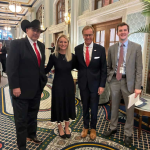Global Elites Release Updated EAT-Lancet Report

Global Elites Release Updated EAT-Lancet Report
Analysis by Cat Urbigkit
Imagine a group of a few dozen elite scientists from the Global North getting together to develop a framework of earth system thresholds, and that framework–despite its conceptual form and varied confidence levels–is then used by financial institutions and governments to guide policies, regulations, and investments for human use of the earth’s resources.
The leader of that elite group then goes on to lead a second elite group of scientists, this time preparing a report calling for transformation of global food systems away from animal products to a predominantly plant-based diet–all in the name of “planetary health.” This new plan includes a prescriptive “planetary health diet” that the elite scientists would like the humans of the world to adopt.
You don’t need to imagine, since that is what happened. Last week’s release of the updated EAT-Lancet report calls for a “great food transformation” with an anticipated global reduction in the livestock sector of 43% by 2050, amounting to a loss of $650 billion in production. More of the reduction would be for ruminant meat (71%), than for non-ruminants (46% reduction) or dairy (20% reduction). The report imagines a 50% reduction in food loss as a key strategy, although how that is viable remains unclear.
But that’s not all – this transformed food system would result in the largest reduction in agricultural land in more than 2,000 years, since any conversion of land for agricultural use would also be halted under its prescription for the global good. The report also prescribes a 70% global reduction in pesticide application, completely halting prophylactic antimicrobial use and halving existing antimicrobial dosage rates from 50 to 25 mg/kg per animal.
The report claims that there is “no safe solution” to the climate and biodiversity crises without this global food systems transformation. Ruminant meat production worldwide would need to decline by 33%, while there would need to be a 63% increase in fruit, vegetable and nut production above 2020 production levels, and fish production would increase by 46% (!).
How it started
The concept of a defined framework of planetary boundaries–thresholds beyond which the risk to humanity could be catastrophic–was popularized by Swedish scholar Johan Rockstrom and a group of about 30 fellow scientists back in 2009. At that time, the authors suggested that three of the nine boundaries had already been transgressed: climate change, biodiversity loss, and shifts in the nitrogen cycle. By 2015, this concept was updated by a smaller group of scientists who reported the addition of another boundary breach: land use change. This update noted that the framework was a work in progress, but the framework was already under consideration by governmental bodies throughout the world, as well as global financial institutions, corporations, non-governmental organizations and philanthropists. By 2023, yet another team of scientists determined that six of the nine planetary boundaries had been transgressed.
Meanwhile, Rockstrom and Walter Willett of the Harvard T. H. Chan School of Public Health co-chaired a team of about 35 co-authors to issue the first EAT-Lancet Commission on healthy diets from sustainable food systems. That report declared that food production is the largest pressure caused by humans on earth and that transformation of the global food system was needed, with major reductions in the consumption of red meat and other animal products, while boosting plant-based eating. Willet’s role in the report is controversial because of his zealous support for a vegetarian diet and his reputation for bullying fellow scientists who may reach conclusions that do not support his position.
Last week’s release of the updated EAT-Lancet report saw its list of co-authors double, but it’s still a group of about 70 scientists who seek to have all of global humanity follow their guidance. The anti-animal agriculture interests pushing this agenda are well organized and have numerous networks and connections.
Among the networks pushing the EAT movement’s Advisory Board, which includes Dr. Johan Rockstrom as its chairman; the Lancet Editor-In-Chief Richard Horton; former PETA vice president Bruce Friedrich, who is also the founder and president of the Good Food Institute, an organization that promotes alternatives to animal products; and a variety of representatives from organizations as varied as the World Bank, Culinary Institute of America, World Business Council for Sustainable Development, United Nations, Royal Phillips, and National Geographic Society.
The EAT-Lancet paper was funded by the Bill & Melinda Gates Foundation, the Rockefeller Foundation, Novo Nordisk Foundation, Wellcome Trust, IKEA Foundation, the Children’s Investment Fund Foundation, and the Cornell Atkinson Center for Sustainability.
By Cat Urbigkit
While the EAT-Lancet report is based on the view that nature conservation depends on policies and actions that provide protection from human activities (especially agriculture), this is in sharp contrast to the perspective of a group of European landscape scientists published earlier this year.
A paper lead by Andrzej Bobiec of the University of Rzeszow in Poland (and joined by academic colleagues in the UK, Turkey, Hungary, and Italy) notes that traditional agriculture and sustainable family farming should be considered “biocultural refugia” for their role in the provision of multiple ecosystem services, “indispensable for diversity of practices, for food security and biodiversity … the very way of life in harmony with nature and tradition, often at a price of any major economic gain.” These farms contribute not only to biological diversity, but also to public food security, cultural richness, and the general quality of life, the authors note. “Thus, instead of stigmatizing agriculture, patronizing farmers to exert on them green agendas, we should establish an effective ‘umbrella’ or buffer, protecting the autonomy of all remaining smallholder, (semi)subsistence family farms and provide any subsidiary assistance they need to keep going.” The authors also advocate development of re-agrarianisation policies to provide conditions to all who would like to make a living out of smallholder farming.”
The popular belief that restoring human-free “pristine nature” will save the planet implies that the wilder ecosystems are, the more they are capable of ensuring life on Earth for future generations. But the landscape scientists argue that human cultures connected to the environment through subsistence traditional land use (rather than the planet’s own custody of nature) has proven to be efficient biodiversity vehicles. The “hands-off” approach can lead to an irreversible loss of ecological characteristics that have been sustained by hundreds of years of traditional use.
And when scientists use biological indicators to assess the health of an ecosystem, often the indicator is a simplistic measure such as the conservation status of an indicator species that leads to biased diagnosis of an ecosystem’s state and processes and does not reflect the complex interactions involved in the dynamics of a landscape.
Bureaucratic procedures and technical jargon referring to the assessment of specific indicators “provide a strong advantage to experts and conservations over local land users–the true stewards of landscape’s biocultural diversity.” Although most decision-making protocols require some opportunity for public participation, it is generally viewed as conservation professionals “educating” local communities who are then expected to be persuaded to provide agreement. Bobiec’s paper noted this “condescending sense of the mission of conservation” that assumes agriculture to be among the major culprits of biodiversity loss. “This would be justified if only applied to intensive, industrial farming, which however, developed at the expense of traditional-biodiversity-friendly-agriculture.”
“Concentrating on ‘wild nature,’ we allowed sustainable family farming to be subjected to ruthless forces of global market and policy agendas disempowering peasant farmers, leading to landscapes’ cultural severance and destroying socio-ecologically integrated village systems” the paper stated. Conservation incentive programs fail due to the conservationists’ ignorance or disrespect for farmers’ values. Top-down policies that set aside protected areas are easier to implement than the development and sustenance of spatially, ecologically and socially embedded farming, which requires respect for its autonomy.”
“Autonomous, small, family farms and their communities secure the diversity of local food systems and are thus important factors of food sovereignty and indispensable sources of high nutritional quality,” the paper stated.
The landscape scientists propose that the present use of inefficient, “quasi-authoritarian, top-down model of exerting ‘green’ solutions” be replaced with a system that involves active participation of land use practitioners.
A “fair and equitable involvement of small-scale land users is needed to bring in their intimate understanding of nature and human-nature relations into conservation planning,” Bobiec wrote. “This should be accompanied by an intensive process of knowledge partnership and knowledge co-production where scientific knowledge and local, traditional knowledge can re-focus our ecological knowledge base of conservation, preferably in community-based conservation actions.”
Criticism is discouraged
This “urgent need for a great food transformation” will need $200-$500 billion per year “to support the transformation to healthy, sustainable, and just food systems.” The report outlines methods to achieve this great food transformation, including imposing meat taxes and providing subsidies to shift affordability to particular foods, combining advertising restrictions with mandatory warning labels on what it determines is unhealthy foods, and combining regulatory measures with land-use zoning to halt further ag conversion.
The report goes into what it calls a “just” food system, but since it didn’t mention the preservation of heritage breeds, nor the jeopardy the plan poses to the rich cultural heritage to communities around the globe, I lost interest.
There was no recognition of the fundamental connectedness between humans and animals and the landscape that has developed over thousands of years, the mutual bonds that bind them. There was no recognition of the positive impact to health and well-being that comes from these inter species relationships, or the possible devastating consequences to the biological diversity of the world’s livestock populations should the scheme be adopted, or its potentially devastating impacts on local livestock production, consumers, communities, and ultimately, food sovereignty.
Critics who would question the report’s models and methodology, its oversimplification of complex systems, its reliance on nutritional evidence that leans heavily on association rather than causation, its potential impacts to public health, or who probe the potential conflicts of interests of some of the report’s primary authors and funders, are preemptively discredited.
The report included a warning about bad actors, noting these are primarily corporate interests acting against the public interests. It noted that includes corporations sponsoring scientific studies that align with their interests, “and the dissemination of misinformation aimed at discrediting independent scientific evidence–such as in cases involving scientists sponsored by the meat industry.”
The publication of the EAT-Lancet report was accompanied by an editorial by the Lancet’s Editor-In-Chief, Richard Horton, who predicted, “You will hear criticism” and predicted a “meat-industry led response” to the updated report, suggesting that a network of “mis-influencers–scientists, doctors, and journalists–amplified disinformation to create uncertainty around, and opposition to, the EAT-Lancet findings and recommendations.” A similar “onslaught of attacks” led to the World Health Organization withdrawing its support for the 2019 report. Lancet Editor Horton is himself one of the influencers pushing this agenda and using a scientific publication to do so.
But the scientific, social, and political skepticism and arguments concerning the underlying claims and wisdom made in a proposal for global transformation of the systems used to feed humanity isn’t a byproduct of Big Beef exerting its undue influence. It’s the logical consequence of human intelligence reluctant to allow for top-down schemes crafted by elitists that present biased information to impose a predetermined agenda.
In an obvious coordinated campaign, just a few weeks prior to the release of the new EAT-Lancet report, the Changing Markets Foundation released its own report alleging there was a meat-industry orchestrated backlash to the 2019 EAT-Lancet report, and naming meat “mis-influencers.” The Netherlands-based Changing Markets Foundation–founded by two former Greenpeace executives–is committed to the view that “society needs transformational change” and seeks to reduce meat and dairy consumption, using tactics to discredit critics and calling agriculture “Big Meat.” The foundation also has an arm in the United States, but according to its most recent tax filing, its only activity is to provide $675,000 to the Center for Biological Diversity, an organization well known for its anti-livestock ideology.
Yet Another Report
And on Monday, Oct. 13, yet another new report was released. This one was on Global Tipping Points and came from the UK-based University of Exeter but is the result of a conference convened by Rockstrom (creator of the planetary boundaries framework, and the EAT-Lancet report). Rockstrom retains oversight via his co-chair position atop the Swedish-based Earth Commission.
The Tipping Points report, funded in part by the Bezos Earth Fund, finds fault in countries that only include food-based dietary guidelines that do not explicitly reference environmental sustainability in their dietary guidelines. It also bemoans that “livestock products retain strong cultural value in many countries,” which could be a hindrance to changing to plant-based diets.
The report recommends a phase-in of policies “including public food procurement, mandates, taxes and subsidies in favor of plant-based food supply and demand.”




